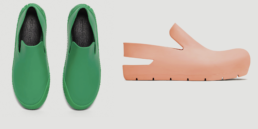Regeneration Through Home Production and Innovation
With the disruptive force of covid 19, globalisation and the decline of traditional work, how do we safeguard against closure of manufacturers, disruption of supply chains and postponed industry events. With overseas travel being precarious and set to continue for some time. Will travelling the world searching for the latest and greatest thing ever be part of a buyer or designers working life ever again? Therefore should home production be at the forefront of every companies strategy?
My thoughts lie in looking at the advantage of localism, home production and technology. A new consciousness is definitely emerging amongst a new generation of creatives and companies seeking to have their products made within the UK. There are so many advantages for different reasons including quality control, flexibility, job creation and sustainability.
It’s estimated there are currently around 280 footwear manufacturers in the UK according to IBSIS world. Could these manufacturers be helped by companies bringing back more business to the UK and should there be government investment – there is a big question of cost before we reach this utopia. Surely if we remodelled certain aspects of the industry today looking at combining additive manufacturing, such as 3-d printing and modernisation of rapid prototyping along with traditional craft this could broaden appeal and could help drive the UK manufacturing industry. Companies such as Ecco and Adidas are already pushing this forward in sneaker production. Consequently prototyping should be used to show customers samples before commitment is made on mould making.
“Hopefully the creative forces in this world can come together, to make new proposals and also showcase proposals that already work.”
UK manufacturing is now operating at 20% less than the 1960’s surely this can be re-addressed. Cleary there is no one size fits all response to boosting home production within the footwear industry. In recent years we’ve had no other option but to be in the detail of the present, flexing costs, margins, overheads, and navigating a market with increased competition. Now is the time we can open up conversations about the long term and how we engage with new ideas to prepare for a less wasteful future.
There is definitely a new consciousness amongst a new generation of creatives and companies seeking to have their products made within the UK. There are so many advantages for different reasons including quality control, flexibility, job creation and sustainability.
— Andrew Thompson

Related Posts
10th April 2021
Spotlight Bottega Veneta’s footwear and communication
To fully recycle sneakers is very…




